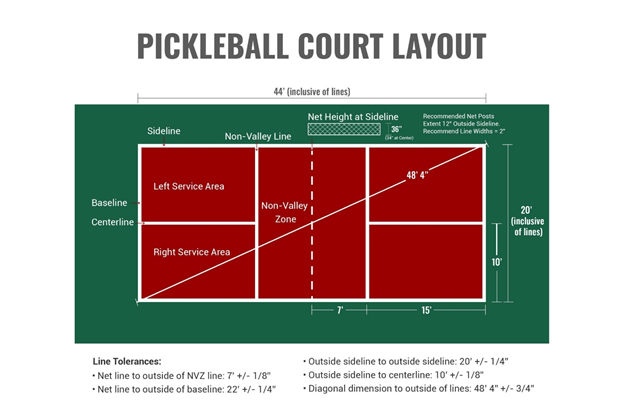Professional Pickleball Court Construction-- From Style to Installation
Professional Pickleball Court Construction-- From Style to Installation
Blog Article
Sustainable Practices in Pickleball Court Construction You Ought To Know
As the popularity of pickleball remains to increase, so also does the demand for lasting methods in court building. This technique not just addresses ecological problems yet likewise improves the longevity and functionality of the courts. From choosing environmentally friendly materials to carrying out reliable drain and energy-saving lights options, there are many methods to think about. Yet, the impact of these practices prolongs much past the court itself. Understanding just how each aspect contributes to a more lasting future welcomes even more exploration right into the elaborate equilibrium in between recreational growth and environmental stewardship.
Selecting Eco-Friendly Materials
Choosing environmentally friendly products is a crucial action in the building of lasting pickleball courts. The selection of lasting products not just reduces environmental impact however additionally boosts the longevity and efficiency of the court. Secret materials include reused rubber for the surface, which uses exceptional longevity and shock absorption while diverting waste from landfills.
Furthermore, making use of locally sourced products lowers transport discharges and supports local economic climates. Pickleball court construction. Utilizing native woods for secure fencing and seating can supply a sustainable visual while making certain strength against the components.
Incorporating permeable products for court structures can better contribute to sustainability by enabling natural water drain and decreasing overflow. These choices not only safeguard local ecosystems yet likewise promote healthier play atmospheres.
Effective Drainage Solutions
While the option of green materials is important, executing effective drainage solutions is just as important for keeping sustainable pickleball courts. Correct water drainage not just safeguards the court surface from water damage however additionally reduces erosion and runoff, advertising ecological honesty.
Efficient water drainage systems can consist of absorptive paving, which permits water to penetrate the ground as opposed to merging externally. This decreases the likelihood of standing water, which can bring about mold and various other upkeep concerns. Furthermore, integrating purposefully put drainage channels and swales can route excess water far from the court location, guaranteeing a dry having fun surface area and stopping soil erosion.
Making use of native plants in the landscaping around the courts can even more boost drainage by taking in excess water and lowering runoff. These plants need much less irrigation and advertise biodiversity, straightening with sustainable techniques.
Furthermore, it is essential to regularly keep the drainage system to guarantee its long-term performance. This includes clearing debris and tracking for clogs. By prioritizing reliable water drainage options, pickleball court fitters can significantly add to the sustainability and durability of the facility, eventually benefiting both players and the environment.
Energy-Efficient Lighting Options
As the need for pickleball remains to expand, incorporating energy-efficient lighting options into court style has actually come to be increasingly crucial for sustainability. Typical lighting systems usually consume excessive energy, adding to higher operational costs and environmental influence. For that reason, embracing modern, energy-efficient technologies is vital for both brand-new building and constructions and renovations.
LED (Light Emitting Diode) lighting stands out as a top choice due to its durability and power cost savings (Pickleball court construction). Compared to standard illumination, LEDs use around 75% much less energy and can last approximately 25 times longer, significantly reducing maintenance costs. The directional nature of LED lighting lessens light pollution, making sure that lighting is focused on the court instead than bordering areas.

Lasting Surface Area Alternatives
Discovering lasting surface alternatives for pickleball courts has gotten grip amongst players and builders alike. The focus on eco-friendly products not just aligns with the growing environmental awareness but also enhances the performance and resilience of the courts.
This material offers superb shock absorption, reducing the danger of injuries for gamers while promoting sustainability. These tiles are very easy to mount and change, and their adaptability allows for different court arrangements.
Natural lawn courts are likewise becoming a sustainable option, advertising biodiversity and reducing the warm island impact. They call for regular maintenance and water, which might not line up with all sustainability objectives.

Water Conservation Techniques

Another efficient technique involves the installment of rain harvesting systems. These systems gather and save rain for usage in maintaining court surfaces and landscaping. This strategy not only saves potable water however likewise lowers dependence on community resources.
Furthermore, utilizing drought-resistant landscape design around the courts is necessary. Indigenous plants require less water and are better adapted to regional environment conditions, therefore reducing general water intake. In addition, making use of reliable irrigation systems, such as drip irrigation, makes certain that water is delivered directly to plant roots, lessening dissipation and waste.
Final Thought
Integrating sustainable practices in pickleball court building significantly adds to ecological conservation and source performance. Making use of eco-friendly products, applying reliable drain options, and adopting energy-efficient lighting options can considerably reduce ecological impact. Furthermore, exploring lasting surface choices and utilizing water conservation strategies web link boost the total sustainability of these leisure centers - Pickleball court construction. By focusing on these practices, the building of pickleball courts can align with wider environmental objectives while promoting long life and capability within communities.
As the popularity of pickleball continues to climb, so also does the need for sustainable practices in court construction.Picking environmentally friendly products is a vital action in the building of sustainable pickleball courts. By focusing on energy-efficient lights choices, pickleball court contractors can contribute to an extra sustainable future while fulfilling the requirements of gamers and stakeholders alike.Integrating sustainable surface area options not only improves the performance of pickleball courts yet likewise paves the means for applying reliable water preservation methods.Incorporating lasting techniques in pickleball court building and construction significantly adds to environmental conservation and resource performance.
Report this page